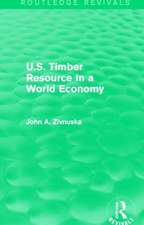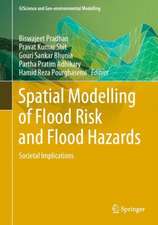Water, Land, and Forest Susceptibility and Sustainability, Volume 2: Insight Towards Management, Conservation and Ecosystem Services: Science of Sustainable Systems
Editat de Uday Chatterjee, Biswajeet Pradhan, Suresh Kumar Kailasa, Sourav Saha, Mohammad Zakwanen Limba Engleză Paperback – 23 mar 2023
This second volume focuses on environmental management, conservation, and ecosystem services and provides information on forest, land, and water resources, presenting in integrated manner various aspects of their characterization, susceptibility, and sustainability.
- Presents theoretical context and practical solutions for understanding the current knowledge and where future efforts should be directed
- Includes case studies in each chapter demonstrating the use of geospatial technologies
- Offers an interdisciplinary approach to addressing susceptibility and achieving sustainability
Preț: 678.01 lei
Preț vechi: 882.47 lei
-23% Nou
Puncte Express: 1017
Preț estimativ în valută:
129.75€ • 134.96$ • 107.12£
129.75€ • 134.96$ • 107.12£
Carte tipărită la comandă
Livrare economică 05-19 aprilie
Preluare comenzi: 021 569.72.76
Specificații
ISBN-13: 9780443158476
ISBN-10: 0443158479
Pagini: 514
Dimensiuni: 191 x 235 mm
Greutate: 0.88 kg
Editura: ELSEVIER SCIENCE
Seria Science of Sustainable Systems
ISBN-10: 0443158479
Pagini: 514
Dimensiuni: 191 x 235 mm
Greutate: 0.88 kg
Editura: ELSEVIER SCIENCE
Seria Science of Sustainable Systems
Public țintă
Environmental researchers, particularly in the fields of land use planning, geography, soil science, environmental and civil engineering, natural resources, and GISCuprins
SECTION I: Introduction: Natural Resources Management, Conservation, and Ecosystem Services Approaches Towards Sustainability
1. Natural Resources Sustainability and Ecosystem Services - A Paradigm Shift
SECTION II: Water Resource Susceptibility and Sustainability
2. A Mathematical Model-based Approach to Assessing Water Pollution Through the Dynamics of Freshwater Zooplankton Community and Remediation
3. Soil-Water Modeling as a Tool for Sustainable Soil Resources Management: Progress and Future Directions
4. Valuing Ecologically Sensitive Areas Ecosystem Services in Bhitharkanika: Implications for Sustainable Management
5. A Comparative Analysis of Changes in Surface Water Resources in Dry and Wet Areas of Zimbabwe Between 1990 and 2020: The Case of Mazowe and Mberengwa Districts
6. Assessment of Covid-19 Lockdown Impact on Surface Water Quality Using Remote Sensing Techniques in Raipur, Chhattisgarh, India
7. Description of the Processing Technique for the Monitoring of Marine Environments with a Sustainable Approach Using Remote Sensing
SECTION III: Land Resources Susceptibility and Sustainability
8. Sustainable Land Use Management and Drivers of LULC Change and Degradation: An Assessment of Malappuram Metropolitan Region, Kerala, India
9. Mapping Alternative Solid Waste Disposal Sites using Fuzzy- DEMATEL Method in Coastal City of Visakhapatnam, Andhra Pradesh (India)
10. Urban Land-Use Susceptibility and Sustainability-Case Study
11. Assessing Urban Land Use Sustainability: Asansol Durgapur Planning Area, West Bengal, India
12. Geospatial Modelling for Sustainability of Soil Ecosystem Services in Hilly and Mountainous Landscapes
SECTION IV: Forest Resource Susceptibility and Sustainability
13. Aspects of Forest Degradation and Inventory Approaches for Forest Management
14. Forest and Livelihood Susceptibility and Sustainability in Relation to Trekking and Tourism: A Study in Singalila National Park of India
15. The Impact of Human Footprints on Forest Resource/Reserve: A Case for Sustainable Forestry in Stubb Stubbs Creek Forest Reserve (SCFR), Akwa Ibom State, Nigeria
16. Shifting Cultivation in the East Garo Hills, Meghalaya (India): An Earth Observation Perspective
17. The Impact of Anthropogenic Activities on Mangrove Forest Health in Urban Areas of the Niger Delta: Its Susceptibility and Sustainability
1. Natural Resources Sustainability and Ecosystem Services - A Paradigm Shift
SECTION II: Water Resource Susceptibility and Sustainability
2. A Mathematical Model-based Approach to Assessing Water Pollution Through the Dynamics of Freshwater Zooplankton Community and Remediation
3. Soil-Water Modeling as a Tool for Sustainable Soil Resources Management: Progress and Future Directions
4. Valuing Ecologically Sensitive Areas Ecosystem Services in Bhitharkanika: Implications for Sustainable Management
5. A Comparative Analysis of Changes in Surface Water Resources in Dry and Wet Areas of Zimbabwe Between 1990 and 2020: The Case of Mazowe and Mberengwa Districts
6. Assessment of Covid-19 Lockdown Impact on Surface Water Quality Using Remote Sensing Techniques in Raipur, Chhattisgarh, India
7. Description of the Processing Technique for the Monitoring of Marine Environments with a Sustainable Approach Using Remote Sensing
SECTION III: Land Resources Susceptibility and Sustainability
8. Sustainable Land Use Management and Drivers of LULC Change and Degradation: An Assessment of Malappuram Metropolitan Region, Kerala, India
9. Mapping Alternative Solid Waste Disposal Sites using Fuzzy- DEMATEL Method in Coastal City of Visakhapatnam, Andhra Pradesh (India)
10. Urban Land-Use Susceptibility and Sustainability-Case Study
11. Assessing Urban Land Use Sustainability: Asansol Durgapur Planning Area, West Bengal, India
12. Geospatial Modelling for Sustainability of Soil Ecosystem Services in Hilly and Mountainous Landscapes
SECTION IV: Forest Resource Susceptibility and Sustainability
13. Aspects of Forest Degradation and Inventory Approaches for Forest Management
14. Forest and Livelihood Susceptibility and Sustainability in Relation to Trekking and Tourism: A Study in Singalila National Park of India
15. The Impact of Human Footprints on Forest Resource/Reserve: A Case for Sustainable Forestry in Stubb Stubbs Creek Forest Reserve (SCFR), Akwa Ibom State, Nigeria
16. Shifting Cultivation in the East Garo Hills, Meghalaya (India): An Earth Observation Perspective
17. The Impact of Anthropogenic Activities on Mangrove Forest Health in Urban Areas of the Niger Delta: Its Susceptibility and Sustainability






















